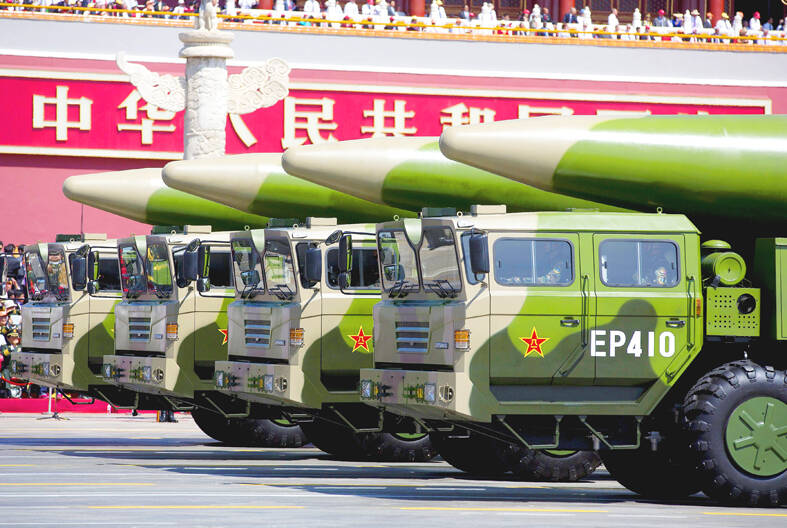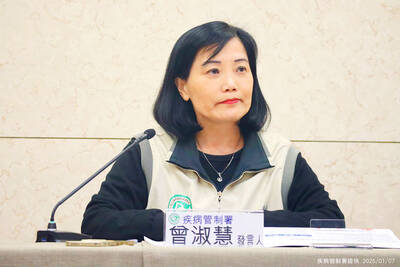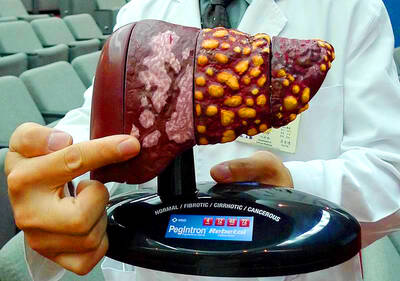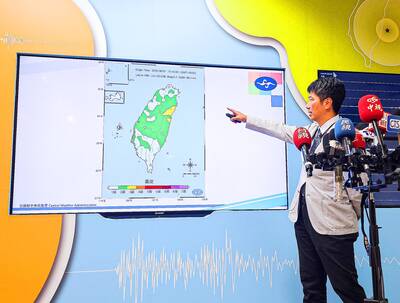China has enlarged its nuclear arsenal to 600 warheads at the fastest rate of nuclear capability expansion among the world’s nuclear powers, the Stockholm International Peace Research Institute said in a report.
The Mainland Affairs Council cited the report, originally published in June, in its latest situation report on China.
Beijing’s nuclear program is expected to build up to 1,500 nuclear warheads by 2035, close to the limit of 1,550 deployed strategic nuclear warheads under the New START between the US and Russia, the institute said.

Photo: REUTERS
The number of nuclear arms in the Chinese People’s Liberation Army’s (PLA) inventory is estimated to be 16 percent of the US’ and 13.9 percent of the Russian arsenal, it said.
The total destructive potential of Chinese nuclear weapons cannot be ascertained due to a lack of information, it said.
Older Chinese nuclear weapons with inferior precision are believed to have a yield of about 1 million tonnes TNT equivalent, while newer and more precise models are believed to have a yield of several hundred thousand tonnes, it said.
Under normal circumstances, most of the PLA’s nuclear weapons are stowed in storage facilities and not mounted atop missiles, but the situation might change as China deploys its new weapons in silos and launch vehicles, it said.
The majority of Chinese nuclear weapon delivery systems carry a single warhead, it said.
China’s more modern DF-5B and DF-21 intercontinental ballistic missiles are multiple independent re-entry vehicle designs, carrying up to five and up to three warheads respectively, it said.
Evidence suggests that 50 percent of the PLA’s TF-26 intermediate-range ballistic missiles carry conventional warheads, while the rest are reserved for nuclear payloads, it said.
The DF-27 intercontinental ballistic missile, an intermediate-range or intercontinental ballistic missile undergoing development, is likely to feature a hypersonic glide vehicle with a range of 5,000km to 8,000km, it said.
China’s nuclear triad is heavily biased toward ground-launched weapons, which account for 80.3 percent of its capabilities, while sea and air-launched systems account for 15.4 percent and 4.3 percent respectively, it said.
The lack of concealment offered by land-launch systems is a constraint on China’s ability to use its weapons in a hot nuclear war, the institute said.
The US’ nuclear arsenal is 23 percent land-launched, 55 percent sea-launched and 22 percent air-launched, for a total of 3,500 nuclear warheads, with the addition of 200 tactical nuclear weapons, it said.
The US nuclear triad’s composition is mainly focused on submarines that offer high levels of stealth, while balanced land and air-launched capabilities allow greater flexibility, it said.
The Russian nuclear arsenal is 44.3 percent land-launched, 35 percent sea-launched and 20.3 percent air-launched, for a total of 3,500 nuclear warheads, in addition to 1,477 tactical weapons, the institute said.
Russia’s nuclear capabilities are inferior to the US’ at sea, evenly matched on land, but have a large superiority in tactical nuclear weapons, it said.

The Taipei Summer Festival is to begin tomorrow at Dadaocheng Wharf (大稻埕), featuring four themed firework shows and five live music performances throughout the month, the Taipei Department of Information and Tourism said today. The festival in the city’s Datong District (大同) is to run until Aug. 30, holding firework displays on Wednesdays and the final Saturday of the event. The first show is scheduled for tomorrow, followed by Aug. 13, 20 and 30. To celebrate the 30th anniversary of Disney Pixar's movie Toy Story, the festival has partnered with Walt Disney Co (Taiwan) to host a special themed area on

BE CAREFUL: The virus rarely causes severe illness or death, but newborns, older people and those with medical conditions are at risk of more severe illness As more than 7,000 cases of chikungunya fever have been reported in China’s Guangdong Province this year, including 2,892 new cases last week, the Centers for Disease Control (CDC) yesterday said it is monitoring the situation and considering raising the travel notice level, which might be announced today. The CDC issued a level 1 travel notice, or “watch,” for Guangdong Province on July 22, citing an outbreak in Foshan, a manufacturing hub in the south of the province, that was reported early last month. Between July 27 and Saturday, the province reported 2,892 new cases of chikungunya, reaching a total of 7,716

STAY VIGILANT: People should reduce the risk of chronic liver inflammation by avoiding excessive alcohol consumption, smoking and eating pickled foods, the physician said A doctor last week urged people to look for five key warning signs of acute liver failure after popular producer-turned-entertainer Shen Yu-lin (沈玉琳) was reportedly admitted to an intensive care unit for fulminant hepatitis. Fulminant hepatitis is the rapid and massive death of liver cells, impairing the organ’s detoxification, metabolic, protein synthesis and bile production functions, which if left untreated has a mortality rate as high as 80 percent, according to the Web site of Advancing Clinical Treatment of Liver Disease, an international organization focused on liver disease prevention and treatment. People with hepatitis B or C are at higher risk of

Aftershocks from a magnitude 6.2 earthquake that struck off Yilan County at 3:45pm yesterday could reach a magnitude of 5 to 5.5, the Central Weather Administration (CWA) said. Seismological Center technical officer Chiu Chun-ta (邱俊達) told a news conference that the epicenter of the temblor was more than 100km from Taiwan. Although predicted to measure between magnitude 5 and 5.5, the aftershocks would reach an intensity of 1 on Taiwan’s 7-tier scale, which gauges the actual effect of an earthquake, he said. The earthquake lasted longer in Taipei because the city is in a basin, he said. The quake’s epicenter was about 128.9km east-southeast